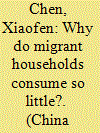|
|
|
Sort Order |
|
|
|
Items / Page
|
|
|
|
|
|
|
| Srl | Item |
| 1 |
ID:
193024


|
|
|
|
|
| Summary/Abstract |
The Republic of Korea Government implemented a universal consumption subsidy program to combat the coronavirus disease 2019 (COVID-19) economic downturn in 2020. Using granular, micro-level transaction data, we find that the subsidy scheme has stimulated household consumption immediately after receipt. Moreover, lower income groups demonstrate higher marginal propensity to consume than middle and higher income groups; this holds true even when creating synthetic control groups that model rational spending behavior. This can have a significant implication on the effectiveness of fiscal impulse. Using income and average historical credit card spending, we also demonstrate credit and liquidity constraints are major factors affecting consumption responses.
|
|
|
|
|
|
|
|
|
|
|
|
|
|
|
|
| 2 |
ID:
161834


|
|
|
|
|
| Summary/Abstract |
Exploring data from the migrant and urban household surveys of the Chinese Household Income Project, this paper dissects the underlying causes of the depressing effect of the hukou system on migrant household consumption to two channels. On one hand, migrants' disentitlement to local urban hukou creates financial insecurity through barriers to employment, social welfare, medical insurance, etc., thereby encouraging precautionary saving. On the other hand, it promotes temporary migration, allows divergence in tastes and values from local urban residents to persist, and incentivizes migrant households to save their transitory income. Factors reflecting these two channels, such as medical and pension insurances, the duration of migration, and local homeownership, are specifically modeled, and they are found to contribute to the discrepancies in consumption between migrant and local urban households, among other factors. In addition, the marginal propensity to consume exhibits heterogeneity across migrant households; it is higher with a longer duration of migration, local homeownership, and self-employment. The lack of these attributes further reinforces the reluctance of migrant households to consume.
|
|
|
|
|
|
|
|
|
|
|
|
|
|
|
|
|
|
|
|
|